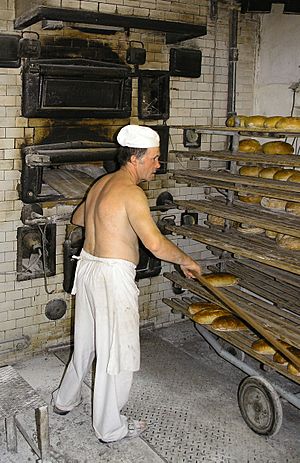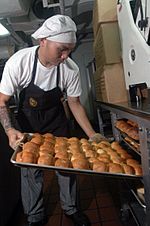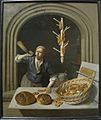Baker facts for kids

A baker is somebody who makes mainly bread. Some bakers also make cakes and desserts, but a traditional baker only makes bread. The place where a baker works is called a bakehouse or a bakery.
The first bread was made by the Egyptians in 8000 BC and in the Middle Ages most landlords had a bakery. They had a public oven and housewives brought the dough to the baker to cook.
Bread is now much sweeter than it was in the Middle Ages because a lot of corn syrup or honey is used. They baked lots of breads.
Contents
History
Since grains have been a staple food for millennia, the activity of baking is a very old one. Control of yeast, however, is relatively recent. By the fifth and sixth centuries BCE, the ancient Greeks used enclosed ovens heated by wood fires; communities usually baked bread in a large communal oven.
In ancient Rome several centuries later, the first mass production of breads occurred, and "the baking profession can be said to have started at that time." Ancient Roman bakers used honey and oil in their products, creating pastries rather than breads. In ancient Rome, bakers (Latin, pistor) were sometimes slaves, who were (like other slave-artisans) sometimes manumitted.
The Gauls are credited with discovering that the addition of beer froth to bread dough made well-leavened bread, marking the use of controlled yeast for bread dough.
In medieval Europe, baking ovens were often separated from other buildings (and sometimes located outside city walls) to mitigate the risk of fire. Because bread was an important staple food, bakers' production factors (such as bolting yields, ingredients, and loaf sizes) were heavily regulated. For example, Henry III of England promulgated the Assize of Bread and Ale in 1267, subjecting all commercial bakers and brewers to various fees in order to practice their trade and imposing various regulations, such as inspection and verification of weights and measures, quality control, and price controls. Soon after the enactment of the Assize, "baking became a very stable industry, and was executed much more professionally than brewing, resulting in towns and villages having fewer bakers than brewers." Because ovens were expensive capital investments and required careful operation, specialized bakeries opened.

As a surname
Baker is an easily recognizable English surname of medieval occupational origin; Baxster is the female form. Equivalent family names of occupational origin meaning "baker" exist in other languages: Boulanger, Bulinger, Dufour, and Fournier in French, Pfister and Becker in German, and Piekarz in Polish.
Duties and occupational hazards
According to the Occupational Outlook Handbook (OOH) published by the Bureau of Labor Statistics of the United States Department of Labor,
{{quote|Bakers typically do the following:
- Check the quality of baking ingredients
- Prepare equipment for baking
- Measure and weigh flour and other ingredients
- Combine measured ingredients in mixers or blenders
- Knead, roll, cut, and shape dough
- Place dough into pans, into molds, or onto baking sheets
- Set oven temperatures
- Place items into ovens or onto grills
- Observe color and state of products being baked
- Apply glazes, icings, or other toppings
Bakers produce various types and quantities of breads, pastries, and other baked goods sold by grocers, wholesalers, restaurants, and institutional food services. Some bakers create new recipes.
Bakers encounter a number of occupational hazards. OOH reports that bakeries, "especially large manufacturing facilities, are filled with potential dangers such as hot ovens, mixing machines, and dough cutters. As a result, bakers have a higher rate of injuries and illnesses than the national average. Although their work is generally safe, bakers may endure back strains caused by lifting or moving heavy bags of flour or other products. Other common risks include cuts, scrapes, and burns. To reduce these risks, bakers often wear back supports, aprons, and gloves."
Baker's asthma—commonly caused by flour allergens and the microbial enzymes (often Aspergillus-derived) used to facilitate breadmaking—is one of the common causes of occupational asthma worldwide.
Comparison with pastry chef
Both bakers and pastry chefs make desserts and breads. In some restaurants and shops, a single individual serves in both roles. In other environments, there is a distinction between the two positions, with bakers making breads, rolls, and muffins, and pastry chefs making desserts, such as cakes, pies, tarts, and cookies. Even when both bakers and pastry chefs work in the same place, however, there may be overlap.
Images for kids
-
The Baker (c. 1681); oil-on-canvas painting by Job Adriaensz Berckheyde (1630–1693) now held by the Worcester Art Museum.
-
A rolling pin is used to work dough.
-
A bakery c. 1465; also used for baking hardtacks or sea biscuits
-
Bakery in Riyadh with traditional Afghan Bread (Tamees)
See also
 In Spanish: Panadero para niños
In Spanish: Panadero para niños









